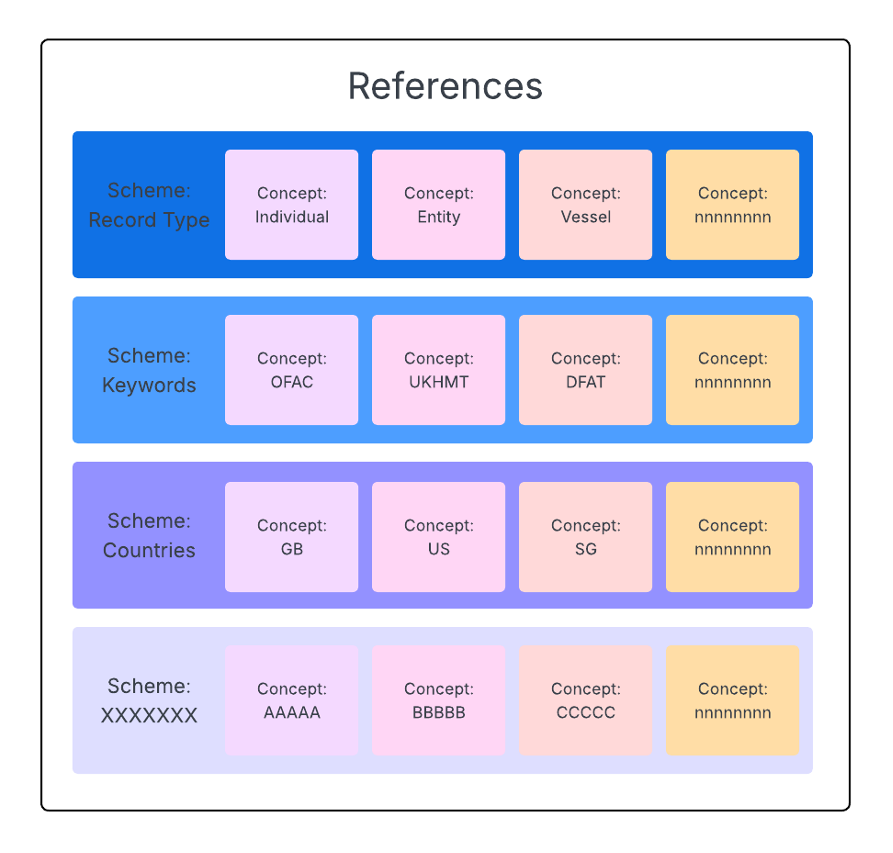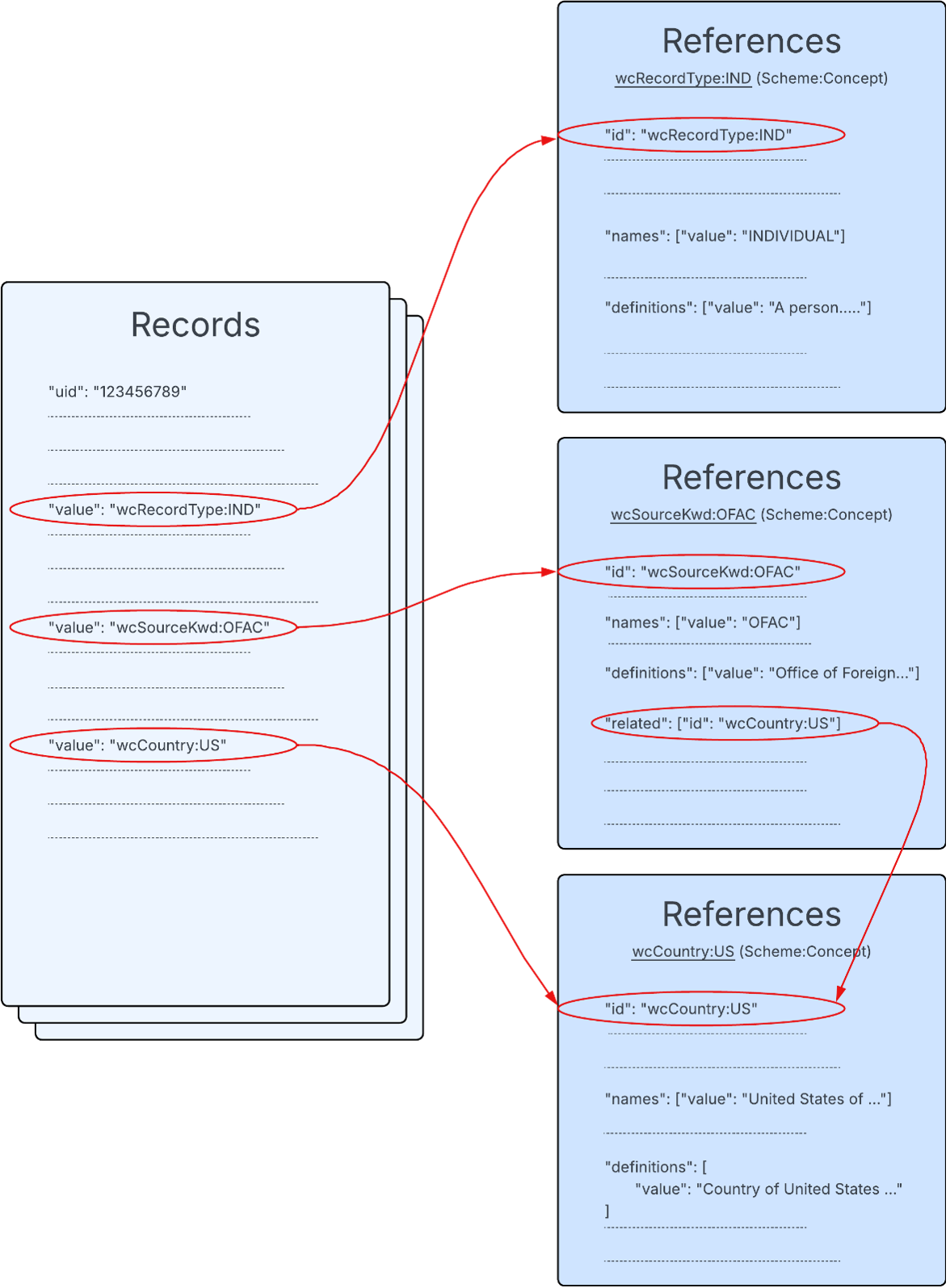Data Concepts
World-Check On Demand provides two general types of data:
- Records
- References
Records
World-Check Records contain details about the record subject such as names, dates, and locations, along with other attributes that provides more context regarding the record itself, such as publication times and history of changes.
References
References are the attributes used to provide context about the record subject. They are records in the technical sense, but each one provides details about the reference entry, such as the friendly name, concept ID, effectivity dates, description, and other related attributes.
World-Check On Demand references and records data are provided via separate API endpoints.
| Data Types | API Resource Path | Description |
|---|---|---|
| Records | /records | World-Check Records |
| References (schemes) | /schemes | Schemes |
| References (concepts) | /schemes and /concepts* | Concepts |
*See the Filters for detailed usage of these resource paths
The records use schemes (e.g., Record Types) and specific concepts within them (e.g., Individual Record Type) to provide additional context to the data. These entries are represented by unique qualified codes (Q_CODE) that must be referenced by consuming applications to fully interpret the record data. The concepts have properties that are human readable as well as machine readable codes. Records returned via the API contain the latter; however, human-readable equivalents are provided in this document where appropriate.
The following diagram illustrates the conceptual relationships between schemes and concepts, as well as between the reference and record data.

Concepts
Concepts are reusable entities that provide meaning to attributes or metadata. They are the fundamental building blocks within a specific domain and are grouped together within schemes (see below). They are used to provide meaning to data elements in a World-Check record. Examples of concepts include the Individual record type (concept ID = IND), or the Office of Foreign Assets Control (concept ID = OFAC). Concept IDs are unique within schemes.
Schemes
These are collections or structures that organise concepts. They act as containers for concepts, allowing the latter’s consistent application across different parts of a World-Check record. Examples of schemes include the Record Type (scheme ID = wcRecordType) which contains all record types such as IND, and the Source Keywords (scheme ID = wcSourceKwd) which contains all keywords (such as OFAC). Scheme IDs are unique across the entire reference data.
Qualified Codes
A specific concept within a particular scheme is unique within World-Check On Demand’s reference data universe. This is normally written in the {scheme ID}:{concept ID} notation and is referred to as the qualified code. Examples of qualified codes are:
| Qualified Code | Description |
|---|---|
wcRecordType:IND | Individual record type |
wcSourceKwd:OFAC | Keyword representing Office of Foreign Assets Control |
wcCountry:CA | Country of Canada |
wcPepPosition:CA | The record subject holds or held the position of candidate |
wcFurtherInformation:CANADA | Additional information provided by Canada related to sanctions |
Concepts should always be referred using its full qualified code to avoid ambiguity.
This diagram shows how qualified codes in World-Check On Demand records relate to the respective entries in the reference data:

Common Record Properties
World-Check On Demand records contain many common properties across different areas of the record schema. Here are the most salient of these.
| Property | Description |
|---|---|
id | Objects that are tracked for changes (i.e., added, updated, removed) are assigned a unique value. In addition to appearing within the tracked object, these “id” values appear in the Change History area for ease of determining which items have been actioned in the record within a given period. This value is unique within a given record. |
isDefault | Fields that support multiple values will have the default value indicated where required. For example, a record with multiple Primary Names will have one that is considered the default value. The default value is based on an internal ranking of data sources. |
relations | An array of related properties indicating a relationship between a parent and child properties. These relationships are shown in the examples of each data feature in this document. |
rel: wcRelatedRel:HAS_KEYWORD_TAG | Values that originate from sources with World-Check keywords are tagged accordingly with lookup values in the Keyword Reference List. Where this applies, values will be appended with this related relationship property. |
value | The main value of an object. This is further contextualised by the value’s data type (see below). For example, a name value could have a value of “ACME International”, with a data type of wcDataType:STRING. |
valueDataType | The data type providing context to the associated data value. This field is usually present when a value is specified. For example, wcDataType:STRING and wcDataType:DATE. Qualified code values (see below) will take on the wcDataType:Q_CODE data type. |
valueDataType: wcDataType:Q_CODE | The corresponding value of value within the same object is a qualified code, in {scheme id}:{concept id} format which indicates an enumerated list of values within the references data. For example, the code for a particular keyword from the list of keywords, like wcSourceKwd:OFAC. |
Date Attributes
World-Check On Demand uses various date formats that conforms to the ISO-8601 standard. Below is an overview of the various dates and examples of where these are found.
Date Formats
| Item | Types of Date | Data Format Example |
|---|---|---|
| Common Date Formats | Example types include: - Deceased Date - Reported Date of Birth - Calculated Year of Birth - Date of Registration | YYYY-MM-DD YYYY-MM YYYY |
Effective From / To
| Property | Definition | Data Format Example |
|---|---|---|
effectiveFrom | The "effective from" date, as specified by the source provider. For example, the date a subject was listed on a sanctions authority source list or the effective start date of a PEP’s position. The date value is always a string. | YYYY-MM-DD YYYY-MM YYYY |
effectiveTo | The "effective to" date, as specified by the source provider. For example, the date a subject was de-listed from a sanctions authority source list or the effective end date of a PEP’s position. The date value is always a string. | YYYY-MM-DD YYYY-MM YYYY |
Current From / To
| Property | Definition | Data Format Example |
|---|---|---|
currentFrom | The "current from" date is provided by World-Check when a starting date has not been provided by the source. The value conforms to RFC3339. | YYYY-MM-DDThh:mm:ss.sssZ YYYY-MM-DDThh:mm:ssZ |
currentTo | The "current from" date is provided by World-Check when an end date has not been provided by the source. The value conforms to RFC3339. | YYYY-MM-DDThh:mm:ss.sssZ YYYY-MM-DDThh:mm:ssZ |
Literal and Normalised Values
Where a source has published a date that does not conform to the standard date formats, then where possible, World-Check will normalise the date value by providing it in one of the date formats. Ambiguous date values like 05-03-2021 that cannot be provided in the standard format will be provided as string values.
| Property | Definition | Data Format Example |
|---|---|---|
wcDataType:STRING | The literal date value as reported on the source is populated to the value field as literal string value. | 2020 March 2024 |
wcDataType:DATE | The normalised date value from the source to meet the prescribed standard format. | YYYY-MM-DD YYYY-MM YYYY |
Min / Max
Where an individual has a year of birth in a range (e.g., born between 1980 – 1982), the record will include the Calculated Year of Birth in a date range format, using minimum / maximum year values two years apart as follows:
| Property | Definition | Data Format Example |
|---|---|---|
wcDateRole:MIN_DATE | Minimum date value in the range. | 1980 |
wcDateRole:MAX_DATE | Maximum date value in the range. | 1982 |